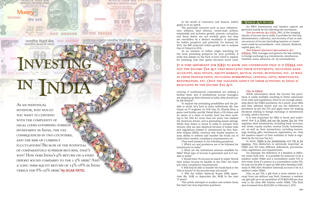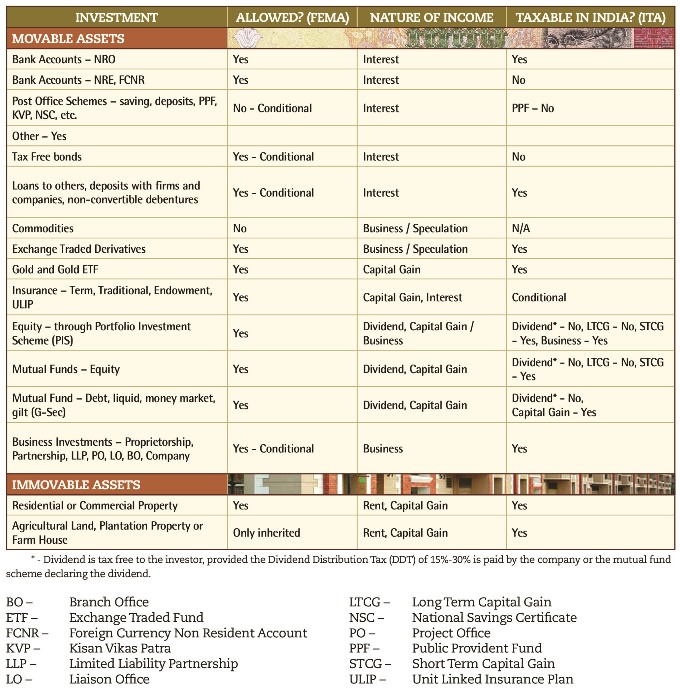Investing in India

As an individual investor, why would you want to contend with the complexity of legal codes governing foreign investment in India, the tax consequences in two countries, and the risk of currency fluctuations? Because of the potential of comparatively superior returns, that’s why! How does India’s 9% return on a fixed deposit sound compared to the 1.5% here? And a long term equity return of 15%-18% in India versus the 8%-10% here?
In the world of commerce and finance, India’s graph is on an uptick.
The perennial concerns such as poor infrastructure, inflation, land reforms, center-state politics, sustainable and inclusive growth, poverty, corruption, and fiscal deficit are not entirely gone, but they are overridden by a distinct escalation of optimism for India’s prospects and potential. On January 20, 2015, the IMF projected India’s growth rate to surpass that of China’s in 2016.
As an investor of Indian origin searching for the most promising prospects for your portfolio, if India was always on the back of your mind to explore for investing, now that option becomes much more enticing. If multinational corporations are making a beeline there and if professional money managers are stepping up their interests in India, why should you be left behind?
To explore the promising possibilities and the pitfalls to avoid, let’s look at three individuals: Mr. Dev Gopal, an IT engineer on H1B visa, Dr. Sharda Jivan, a green card holder, and Mr. Vishal Shah, a US citizen and an owner of a chain of motels. Each has been residing in the USA for more than ten years, has realized the American dream, and is generating ample savings. While they desire to invest in India to increase their returns, they are also skeptical because of Indian laws and regulations related to investments by Non Resident Indians (NRIs), currency risk, double taxation issues, ability to redeem and transfer the funds out of India when needed, compliance requirements, etc.
They need answers to the following questions:
1. Which act and provisions are to be followed for
investments in India?
2. What are the investment avenues available for
NRIs? What type of income is generated and is it taxable
in India?
3. Would their US income be taxed in India? Would
their Indian income be taxable in the USA? Are there
any other compliance requirements?
4. Will they be able to transfer the funds back to the
USA in future? Is the process easy and quick?
5. Will the Indian National Rupee (INR) appreciate
(Rs. 30/$) or depreciate (Rs. 90/$) in the next
15 years?
This article attempts to analyze and answer these five basic but very important questions.
1. Which Act to use?
An NRI’s investments and taxation aspects are
governed mainly by the following two provisions:
The Income-tax Act (ITA), 1961, is the charging
statute of Income Tax in India. It provides for the levy,
administration, collection, and recovery of tax on various
sources of income (including taxation on investment
made by nonresidents—rent, interest, dividend,
capital gain, etc.).
The Foreign Exchange Management Act (FEMA), 1999, manages and governs the law relating to foreign exchange (e.g. investments, remittances, transfers, loans, advances, etc. by nonresidents).
ITA or FEMA?
While information about the Income Tax provisions
is easily available resulting in better awareness
of its rules and regulations, there is not enough awareness
about the FEMA provisions. As a result, most NRIs
and their advisors search and use the definition or
provisions as per the ITA and apply them for making
decisions relating to foreign exchange or investments
in India, which is incorrect.
It is very important for NRIs to know and understand that it is FEMA and not the Income Tax Act that regulates their investments, including bank accounts, real estate, equity market, mutual funds, businesses, etc. as well as their transactions, including borrowings, lending, gifts, remittances, repatriation, etc. Only the taxation aspect of their activities in India is regulated by the Income Tax Act.
In short, FEMA is for investments and ITA is for taxation. This distinction is extremely important as FEMA and ITA have different definitions, procedures, rules, regulations, and requirements.
For example, the definition of a Resident is different under both Acts. It is possible for someone to be a resident under FEMA and a nonresident under ITA or vice versa. Even if a person is a nonresident under ITA, he may not be able to open an NRO (Non Resident Ordinary) or NRE (Non Resident External) account if he is a resident under FEMA.
Also, as per ITA, a gift from a close relative is exempt from tax without any limit. However, a resident can give gift up to an equivalent of US $250,000 per year only to his close NRI relative under FEMA. This limit was increased from $125,000 on February 3, 2015. It is very important for NRIs to know and understand that it is FEMA and not the Income Tax Act that regulates their investments, including bank accounts, real estate, equity market, mutual funds, businesses, etc. as well as their transactions, including borrowings, lending, gifts, remittances, repatriation, etc. Only the taxation aspect of their activities in India is regulated by the Income Tax Act.
2. Investment options for NRIs:
Almost ALL investment options that are available to a resident Indian are also available to NRIs. In addition, to attract foreign exchange and retain investments made by NRIs, the rules have been made more beneficial for them. For example, interest on NRE bank accounts is exempt from tax in India for an NRI, whereas a resident would have to pay tax on interest from his resident bank accounts.
The investment options available to NRIs, including US residents (under FEMA), nature of income generated from each investment option and whether the income is taxable in India (under ITA) are summarized in the following table. Full forms of the abbreviations appear in alphabetical order below the table.
While Reserve Bank of India (RBI) allows investments by US residents, certain financial institutions may not accept investments from US residents due to their internal policies or compliance constraints. For example, as of February 11, 2015, the HDFC mutual fund is not accepting new investments from US residents.

3. Taxation of foreign income:
Taxation in India of an NRI’s foreign income:
Only Indian income is taxable for an NRI in India.
An NRI would not pay tax on any foreign (US) income
in India. In our example, as Mr. Gopal, Dr. Jivan, and Mr.
Shah reside in the USA and are not residents of India,
their US income is not taxable in India and is not included
in their Indian income tax return.
Taxation of an NRI’s Indian income in the USA:
Global income is taxable for US residents, irrespective
of their immigration status. As Mr. Gopal, Dr. Jivan,
and Mr. Shah live in the USA, they are considered US
residents for income tax purposes and their global income
(including from India) will be included in their US
tax returns, even if it is tax free in India. For example,
while interest on NRE bank accounts is exempt from tax for
NRIs in India, a US resident is required to include it in his
income tax return and pay tax in the USA.
Also, if any tax on any income is deducted/paid in India (e.g. TDS on NRO bank interest), a US resident would not have to pay the tax twice but would be able to claim the tax paid/deducted in India as a foreign tax credit on his US tax return.
US Compliance Requirements for foreign
investments:
US residents are also required to comply with two
important requirements:
a. Report of Foreign Financial Accounts (FBAR): A US resident having a balance of $10,000 or more in aggregate in foreign financial accounts at any time during the year is required to file the FBAR form (Fin- CEN Report 114) electronically to the Department of Treasury by June 30th of the next year.
b. Report of Foreign Financial Assets (Form 8938): Under FATCA (Foreign Account Tax Compliance Act), a US resident living in the USA and having foreign financial assets over $50,000 on last day or $75,000 at any time during the year ($100,000 / $150,000 if married filing jointly) is required to file Form 8938 giving details of the assets and income generated from those assets to the IRS with their federal return (1040).
4. Remittance and Repatriation:
RBI, over a period of time, has made it very easy for
NRIs to transfer funds into and out of India. The limit,
procedures, and requirements may be different based
on whether the original source of funds is internal (Indian
savings) or external (US or foreign savings).
The NRE account is used for external source of funds and is considered as a fully repatriable account, meaning that the US resident is allowed to bring back the funds to the US without any restrictions. All nonrepatriable funds and funds with Indian sources are maintained in the NRO account.
Transfer out of NRO Account:
Funds in an
NRO account can only be transferred abroad subject to
certain limits, conditions, and procedures.
a. The current income (e.g. rent, interest, etc.) can be freely transferred from an NRO account to a foreign country or to an NRE account subject to the payment of taxes and CA certificate without any limit.
b. The funds from the NRO account or from the sale proceeds of assets, including sale of immovable property can be transferred abroad up to an equivalent of US $1,000,000 per financial year, subject to payment of taxes and CA certificate, without the permission of the RBI. On May 7, 2012, the RBI has also allowed the transfer of funds from an NRO account to an NRE account subject to the same overall ceiling of USD $1,000,000.
Fully repatriable NRE accounts and the remittance limit of up to $1 million per year out of NRO accounts make it easier for NRIs to transfer the funds into India (invest) and out of India (redeem).
5. Currency Risk:
Every investor investing in India from abroad is
looking for a higher return in his resident currency.
While the INR return could be better, return in USD matters
to the American investor. As a result, the future exchange
rate, i.e. when he actually sells his investment
and converts INR into foreign currency, would matter
and could materially affect his return.
INR has a long history of depreciation against USD. INR has depreciated at the rate of 4.5% per year since 1948 (3.31/$ in 1948 to 60/$ in 2014) and at the rate of 3.3% per year since 1995 (32.43/$ in 1995 to 60/$ in 2014).

Conservatively, an NRI may plan to expect INR depreciation of 4% per year in future. Of course, INR may not depreciate evenly every year and the long term average rate of depreciation could decrease/increase due to market sentiments, international events, micro and macro-economic factors. But, in the long term, the rupee will depreciate. In 2030, I see higher chances of 1 USD = INR 90 than 1 USD = INR 30.
If an NRI is not ready for rupee depreciation, he should not invest in India or any other emerging markets directly, or indirectly through emerging market funds available in USD in the USA. However, even after adjusting for INR depreciation, investments in India could help an NRI earn higher returns compared to the USA.
Conclusion:
Investing in India offers tremendous opportunities to increase returns and grow the investor’s wealth. Also, it is prudent to diversify the investments geographically and in more than one currency.
Yes, a US resident would have to report the investments, pay the tax, and comply with IRS, Treasury, or any other requirements. In spite of that, return on bank FD of 9% in India is still better than 1.5% in the USA and long term equity return of 15%-18% in India is still better than 8%-10% in the USA. Even after adjusting for currency risk, income tax, and compliance costs, a US resident would still end up with higher returns by investing in India. That is the reason why Foreign Institutional Investors (FIIs) and NRIs/PIOs have already invested billions of dollars in India and are still investing billions of dollars every year.
While there are challenges to India’s growth, the question Mr. Gopal, Dr. Jivan, Mr. Shah or any other NRI need to answer is “Are you going to join other investors to create multigenerational wealth by investing in India or have tax, compliance, and currency concerns weigh on your investment decisions and miss the opportunity?”
Jigar Patel, CFA (USA), MBA-Finance (USA), CA (India), specializes in NRI investments, taxation and wealth management. His NRI advisory has received the “Customer Centric Business of the year” award in India by Intuit and Bloomberg TV India. He has also authored a book, NRI Investments and Taxation: A Small Guide to Big Gains. He can be reached at jigar@nareshco.com .
Disclaimer: All investments are subject to market risks. This information has been prepared solely for general information purposes and is not intended to constitute a recommendation, offer, or advice. The information herein is subject to change without notice and has been obtained from various sources considered to be authentic and reliable. Before making any decision you should consider whether the information is appropriate in light of your needs and consult an accountant, CPA, financial advisor, or an attorney. The views are personal and neither the author nor the firm or any other person or entity guarantee its accuracy or completeness, and disclaim any and all liability to anyone for any loss or damage caused by error, omission, or inaccuracy. Neither the author, firm, nor publisher assumes any responsibility for the interpretation and/or use of information contained herein, nor does it offer a warranty of any kind, either expressed or implied.
Enjoyed reading Khabar magazine? Subscribe to Khabar and get a full digital copy of this Indian-American community magazine.
blog comments powered by Disqus












